Welcome to a new year. Last year there were a few hot periods across the different lakes but for the biggest part, the fishing was pretty tough. Let’s hope that this year brings better and more consistent fishing.
Rather than deliver the usual fishing reports for each area, I thought I’d run with something different for the start of the year. This month, we’ll take a look at several freshwater species, some hot lures, techniques and locations to try and catch them.
I thought about where to source information as to what is selling and working well in the different areas. The answer wasn’t far away and after a quick call, Carl Jocumsen was only glad to help.
Carl was last year’s winner of the BASS Grand Final and also took out the prestigious title of BASS Angler of the Year. You may have seen him on TV on the AFC either fishing or presenting the show.
Carl’s area of expertise is freshwater fishing. He spends plenty of time on the water and has an uncanny knack for catching fish wherever he goes. You can visit Carl at Fish’n’Bits Bait and Tackle where he works. Fish’n’Bits is located at 340 Alderly Street Toowoomba. I’d like to take the opportunity to thank them for letting Carl off from his arduous chores to discuss the following information. The following is a collation of information from both Carl and my-self.
Carl may be well known for his bass fishing talent but he shares a passion with many others for catching the mighty Murray cod. The Murray cod can grow to over 100lb and the size and power of such fish has created a string of tales and tall stories.
I recall hooking at a beauty in the Condamine River. It swam straight towards the boat. As its monstrous head went underneath me, it started to peel line as it swam off down the river. Unfortunately, the reel only held 30m of line. Just before it popped off at the spool I looked down to see the tail of the fish going past the boat.
Bassman – Codman spinnerbait. The Codman spinnerbait is a bulky lure that carries two thumping blades and a Bozo curl-tail grub trailer on the hook. They’re a good mouthful for big fish.
Australian Crafted Lures – Invader 150. At 150mm long this is a big lure with a big profile. Slowly retrieved it will make plenty of vibration.
Mudeye Lures – The Big One. The name ‘The Big One’ says it all. This is a big lure intended for big fish. And it’s surprising to see many smaller cod won’t hesitate in taking these larger lures as well.
Keep the lure close to the bottom, work it slowly and keep it in this zone. It’s all about putting it in the cod’s face.
Let the lure do the work. There’s no need to impart rod action just keep winding slowly. With the spinnerbait, give it a short, sharp rip to get the big blades working at the start of the retrieve. After that, just keep rolling it along slowly.
Cooby Dam – Target the creek bed drop-off.
Glenlyon Dam – Look for timbered points.
Pindari Dam – Fish in the shallow timbered bays.
Copeton Dam – Cast to points with fish holding structure like rocks and lay-down timber.
The golden perch is more often referred to as the yellowbelly. It has been stocked in most South East Queensland lakes and lives naturally in most river systems. These fish can be caught all year round but are most active in spring and summer. They are suckers for live shrimp and will take a wide range of lures.
Jackall TN60. This lure seems to work on everything in the freshwater. Be sure to check out the new black market colour.
Bassman. The 1/2oz spinnerbait with medium sized blades will do the job. An easy tip to remember is that goldens don’t mind a flash of gold in a lure.
Little Ripper. The 18+ version of this lure is perfect for golden trolling.
The method used to catch these fish depends upon the lure being used. Let’s take a quick look at all three.
The TN60 Jackall is perfect for hopping back to the boat. Cast it to the edge and commence a short retrieve, then let it sink to the bottom. Hop the lure off the bottom by lifting the rod. Control the sinking speed of the lure by lowering the rod tip and staying in touch with it. Keep hopping and following the contour of the bottom on the way back to the boat.
Spinnerbaits are perfect around structure. Goldens will often hold around weed, timber and rocks. If you can wind the spinnerbait slowly over these areas with the occasional pause, you should be rewarded.
The Little Ripper is suited to trolling rather than casting. Troll these lures in 15-20ft of water. Rather than trolling blindly, target the drop-offs to creek beds using a sounder or work along steep rocky banks and points.
Boondooma Dam – When trolling, work the rocky points and steep banks in the main basin. The weedy edges and timbered sections are well suited to casting. Work your lure as close to the structure as possible.
Pindari Dam – Casting lures right into the tops of submerged trees in deepwater will ring the dinner bell for goldens. When trolling, run your lures as close as possible to the steep rocky banks.
Coolmunda Dam – Coolmunda is a lake best suited to trolling. The hot spot is straight out from the boat ramp and dam wall. Troll along the creek bed drop-off in this area.
Carl has spent more time fishing for these battlers than any other species. Part of the attraction to catching them is the range of lures and techniques that can be used. A hot method on one day could be refused the next and this keeps anglers thinking and experimenting. Here are some of Carl’s most reliable lures and locations.
Evergreen Little Max. These blade baits sink fast and stay deep. This allows them to cover water quickly and stay down where the fish often are.
Lucky Craft Sammy 65. These walk-the-dog style surface lures are ideal when used on the right lake at the right time.
Silent Jackall TN60. This silent version of the popular Jackall is often the answer to catching more fish. It provides a more subtle and natural approach. Be sure to check out the new silent brown dog colour.
Three different lures call for three very different techniques.
The Little Max blade bait can be either slow rolled or hopped through schooled fish. It is important to keep it in front of them. Working above the school won’t draw very much interest. These lures sink pretty fast so keep the lure moving and not sitting on the bottom for too long.
The Little Max can also be trolled. Use light line to keep the lure deep in the water column and trail it a long way behind the boat (around 40m).
The Lucky Craft Sammy 65 is a surface lure. This stickbait can be made to walk from side to side. With the right rod action, you can impart a lot of movement without moving the lure forwards too fast. This keeps it in the zone longer. Move the lure forwards about a metre before pausing for a few seconds and continuing the retrieve.
The Silent TN60 Jackall can be fished the same as a standard Jackall. Cast the lure to structure found around the edges of the dams. Look for trees, weed and rocks. Jackalls will also work well around gentle tapering banks and prominent points.
Cressbrook and Maroon Dams – These lakes will be ideal for surface lures. The prime times are early morning and late afternoon. Place casts right up in the shallow water and work the lure back to the boat. Maroon usually produces better quality bass than Cressbrook.
Somerset Dam – Somerset is the home to big bass. Here the fish school in the deeper water. At this time of year, the schools can break up and suspend in the deepwater. When this is the case trolling a Little Max 1/2oz blade bait is a good way to score a few.
Boondooma Dam – After recent rain, the edges of Boondooma should start to fire up. Look for any fresh weed growth and changes in bottom contour. Cast silent Jackalls into these areas to tempt some bass. If schools are found, try rolling and hopping the Little Max blade baits through them. There have been plenty of smaller fish around with some big ones mixed in.
Saratoga are often a by-catch for anglers chasing other species. If you choose the right lures and fishing techniques they can become the target and the chances of success are greatly increased. Keep in mind the toga feed close to the surface most of the time.
Megabass Anthrax. This weird looking surface lure is known to be high on the toga’s menu of favourite lures.
Mazzy Popper. The Mazzy popper has a small bib that allows the lure to be worked on the surface or just under.
Beetle Spin. The Beetle Spin is a combination of a clip-on spinning blades and a jighead rigged soft plastic. Saratoga love them.
When poppering toga with an Anthrax or Mazzy popper, the retrieve is quite easy. The action is given by winding the lure without rod twitches. It’s a very simple technique. The faster the wind, the deeper these lures will want to pull. You can roll them dead slow on top or rip them down a bit. Be sure to pause the lure for several seconds every few metres and don’t be afraid to slow it right down in the fishiest looking areas.
The beetle spin can be rolled through shallow timbered areas. It’s a good alternative when these fish aren’t feeding off the surface. By altering the weight of the jighead to suit the blade and plastic size it can be fished high in the water column.
Cania Dam – Cania Dam produces quite a few toga when targeting other species, but actually fishing for them is likely to produce even better results. Try working the shallow open edges of the lake, the backs of big bays and any form of structure found around the edges.
Borumba Dam – Travel to the timbered arm of the lake. Look for quiet areas with the wind pushing into them. Often the toga can be seen boiling on the surface as they feed.
Hinze Dam – When fishing the Hinze, target saratoga in the backs of bays or around any form of structure (weed, grass or sticks).
The barramundi is truly an awesome impoundment fish. As easy as they are to catch sometimes, they can be just as frustrating when they shut down. Both trolling and casting will work at different times of the year.
Squidgy Slick Rig. The Pro Range of slick Rigs are a very popular barra lure. These soft plastics have a lighter weight system than the original ones.
Berkley Hollow Belly. The new Hollow Belly soft plastic has been very popular among barra anglers since its introduction. The soft nature of the lure allows it to be rolled at extremely slow speeds though you can of course wind them fast when that’s what the fish want.
125 Scorpion. When trolling the open water of lakes or working structure, it’s hard to beat the Scorpion range. They have a number of models to suit different depths.
The Squidgy and Hollow Belly plastics can be cast to all manner of areas. Barra can be found around the trees in lakes like Monduran and Faust or the weed beds of Awoonga. These versatile lures sink so can be fished at a range of depths. Cast them to the fishy areas and wind them back with a steady retrieve. Use a bit of speed variation and throw in the odd pause. Mix it up until you find what the fish want.
When trolling the Scorpions, choose the right lure to suit the depth you are fishing. If trolling the open water, watch the sounder to see how deep the fish and bait are holding. If you are working a drop-off, choose a lure that runs close to the bottom.
When fishing for barra, you increase your chances by having gear that’s up to the job. Smooth drags are a must. Using 30-50lb braided lines will also help when it comes to fighting these powerful fish.
Awoonga – With millions of barra stocked into it, this lake provides plenty of thrills. You can troll the deep water, work along drop-offs throughout the lake or try your luck casting. The weed beds found in the main basin of the lake are ideal for casting plastics. Keep the lure as close to the weed as possible. Night sessions around the full moon can be very productive.
Monduran – The main basin of the lake out from the boat ramps can fish well at times. When it fires, trolling lures produces monster fish over 110cm. It doesn’t fish well all the time and this is when casting becomes the better option. Tossing plastics around the points and bays of the timbered arms will score fish. The secret is to move around until you’ve found a productive area. The main points in the southern arm of B are always worth a look.
Proserpine Dam (Peter Faust) – Faust has long had a reputation for its unstoppable barra in the timber. Look for these fish in the trees around any of the creeks, gullies and bays. Travel through the mass of trees until you reach the banks near such areas and cast away.
All three lure types will work when casting the timber. When fishing with Scorpions, use a very slow retrieve. Trolling the main basin will also produce fish. Look for fish on the sounder and keep working them until they bite. Night sessions will often produce the bigger fish.
At times, freshwater fishing can be tough. When dams shut down, the fish are very hard to tempt. Switched on anglers are always looking for ways to boost their catch rate. When the fishing is hard, it is these guys who stand out among the crowd.
One of the many ways we can increase our catch is to change the lures we are using. Some minor changes here or there can be all it takes to make a lure’s presentation more effective.
Last year’s ABT Barra Tour demonstrated that thinking anglers are often rewarded. Barra guide Jason Wilhelm took out the Teemburra Evening Event and proved this point.
Jason used a slow retrieve starting from the weedy edges of the lake. He chose a Squidgy Slick Rig lure, and to get the desired action from the lure at slow speed, Wilhelm made the necessary changes.
“Boiling them in hot water is something we’ve started to do. It softens the plastic and allows the Slick Rig to swim, roll and shake its tail on the slowest of dead slow retrieves,” explained Wilhelm.
Boiling the whole bait in water (or even just the tails if you prepare a jig to hold the plastics in place) is a great way to soften them up. The properties of the plastic change when boiled; making it softer, more flexible and a little bit sticky.
If you saw the need for a bait of this description but hadn’t had the hindsight to prepare one before you hit the water, it’s not too late. Using a cigarette lighter to heat the tail wrist section of a soft plastic will quickly soften it up. Rotate the lure to try and keep the heat even on all sides. The plastic doesn’t need to be in the flame, just above it. A quick dunk in some water will cool the outside of the plastic down so it doesn’t stick to anything or burn you.
A plastic with an action suited to slower speeds could be useful in many situations. When your target species is bass, barra or even saltwater fish, a heated plastic could help you catch more.
When the bites are slow it is important to make them count. Using blunt and rusty hooks severely increases the chance of missing fish. Chemically sharpened hooks are the quick fix solution to this problem.
When chasing smaller freshwater species like bass and golden perch, ensure you use the right hooks for the job when making the replacement. Try to keep the weight and size of the hooks similar to the originals. This ensures the lure action and buoyancy remain the same. Light gauge hooks are ideal for smaller fish. The thinner diameter allows better penetration with less pressure needed to set them deep.
On bigger lures, such as those designed for barra and cod, it’s hard to find a better treble than the Owner ST66. These hooks are very tough and sharp.
For bigger profiled lures, the ST66 hooks can replace each of the existing hooks. Just try to keep the size the same and throw in some new stronger split rings if necessary. When upgrading fine, light trebles on a lure that carries three sets, it’s best to leave the middle hook off the lure to keep the weight about the same.
After snagging, be sure to check hook points to make sure they haven’t rolled over or snapped off. It’s a good idea to check used hooks against new ones. I’ve made the mistake of feeling the points of the hooks on the lure I’m using and thinking they were sharp. After missing a couple of fish, I compared them to some new ones and the difference was incredible.
You’ve tried all your proven lures and you know there are fish there but they just won’t bite. It could be time to downsize the offering.
One of the most popular lures on the South East Queensland impoundment scene is the Jackall TN60. When the fish are refusing this lure you can try its smaller brother the TN50. Although only 10mm shorter, the profile of this lure is much smaller and a change to this will often produce the strikes.
Australian spinnerbait designers saw the need to downsize spinnerbaits in the early days. You can take things one step further and use a beetle spin. These lures consist of a soft plastic rigged on a jighead with a clip-on wire frame and small Colorado blade. They look similar to a spinnerbait only the skirt is replaced by a plastic and the profile is smaller.
Beetle spins can be used in the same way as a spinnerbait. Jigheads can be changed to suit the depth you are fishing, and they are always worth tossing when fishing in lakes known for saratoga.
Reads: 25621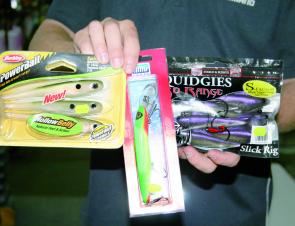
The Hollow Belly, 125 Scorpion and the Slick Rig are all proved lures on freshwater barra.

Three different lures for three very different bass techniques: the Jackall TN60, Sammy 65 and the Evergreen Little Max.

The TN60 Jackall is perfect for hopping back to the boat, which this golden perch just couldn’t resist.
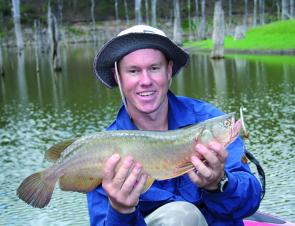
The Beetle Spin is a combination of a clip-on spinning blades and a jighead rigged soft plastic. Saratoga love them.
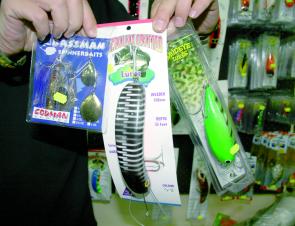
Carl Jocumsen loves his Murray cod fishing, and always takes along the Bassman Codman spinnerbait, Invader 150 and The Big One.
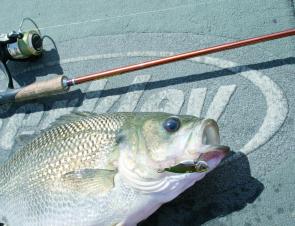
Evergreen Little Max blade baits sink fast and stay deep. This allows them to cover water quickly and stay down where the bass are.
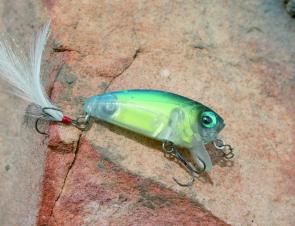
The Mazzy popper has a small bib that allows the lure to be worked on the surface or just under.
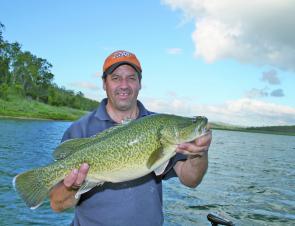
The Murray cod can grow to over 100lb, and the size and power of such fish has been the undoing of many experienced anglers.
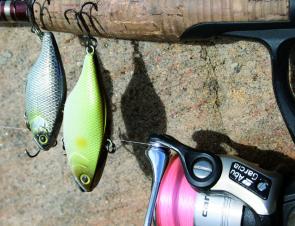
When the fish are refusing to bite, try downsizing your lure. Changing from a Jackall TN60 to a TN50 can make all the difference.




